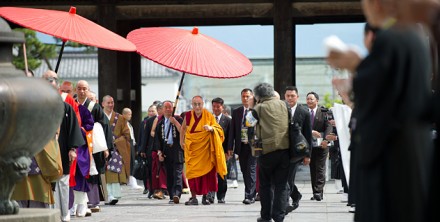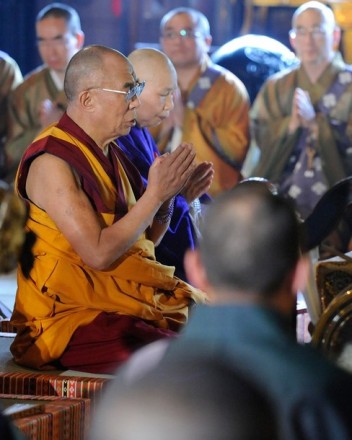
Nagano, Japan: His Holiness the Dalai Lama this afternoon consecrated a sand mandala made by Tibetan monks at Zenkoji Temple.
The creation of Gonpo O-pa-me (Amitabha Buddha or Buddha of Infinite Light) mandala marks the first visit of His Holiness to Zenkoji, a 7th century non-sectarian Buddhist temple, located in the Honshu island. Amitabha is the principal buddha enshrined and worshipped at Zenkoji.
Ten Tibetan monks from the India-based Tashi Lhunpo monastery constructed the mandala which took 16 days to complete. Traditionally, sand mandalas are created in exquisite geometric designs to generate compassion, realize the impermanence of reality, and the cosmic healing of the environment, and then destroyed to symbolize the impermanence of all existence.
But the mandala at Zenkoji will be preserved for posterity so that visitors and devotees could visit it anytime in future. Sand Mandala is an ancient Tibetan art form not common among Japanese Buddhists. The Avalokiteswara mandala is the first sand mandala ever created in the centuries-old history of Zenkoji temple.
According to Venerable Lobsang Dorjee of Tashi Lhunpo monastery, local devotees in Nagano took special interest in the mandala. “Every day we have many local people visiting Zenkoji to watch the process of mandala making; some devotees, stirred by the message of compassion and impermanence embodied in a mandala, broke down in tears,” he said.
After the consecration ceremony, His Holiness the Dalai Lama along with the two chief priests of the temple led a prayer ceremony for world peace and for the victims of the April 14 earthquake that rocked the Tibetan area of Yushu in Qinghai Province. Tibetan monks joined Japanese monks in reciting the Heart Sutra (Tib: Sherab Nyinpo) and the King of Aspiration Prayer for Noble Activity (Tib: Sangcho Monlam) as hundreds of Nagano residents lined up on either side of the temple’s two main gates to listen to the prayers broadcasted through several speakers that were fitted around the temple complex.

Zenkoji Temple is a non-sectarian temple whose religious leaders (a priest and a priestess) share the ritual responsibilities. Historically open to women when other temples were not, now up to 8 million visitors visit Zenkoji annually. Their purpose is a one-in-a-lifetime pilgrimage to ensure salvation by touching the “Key to Paradise” located in a pitch-black passageway under the main altar of the temple.
Dating from 1707, the main temple houses Zenkoji’s most sacred image, an Amida (or Amitabha) triad. Called “Ikko Sanzon Amida Nyorai”, it features three standing images sharing one halo. Never displayed, a replica of the image is revealed periodically. It is considered the first Buddhist image in Japan and arrived via Korea in 552 AD.
–Report filed by Tsering Tsomo

